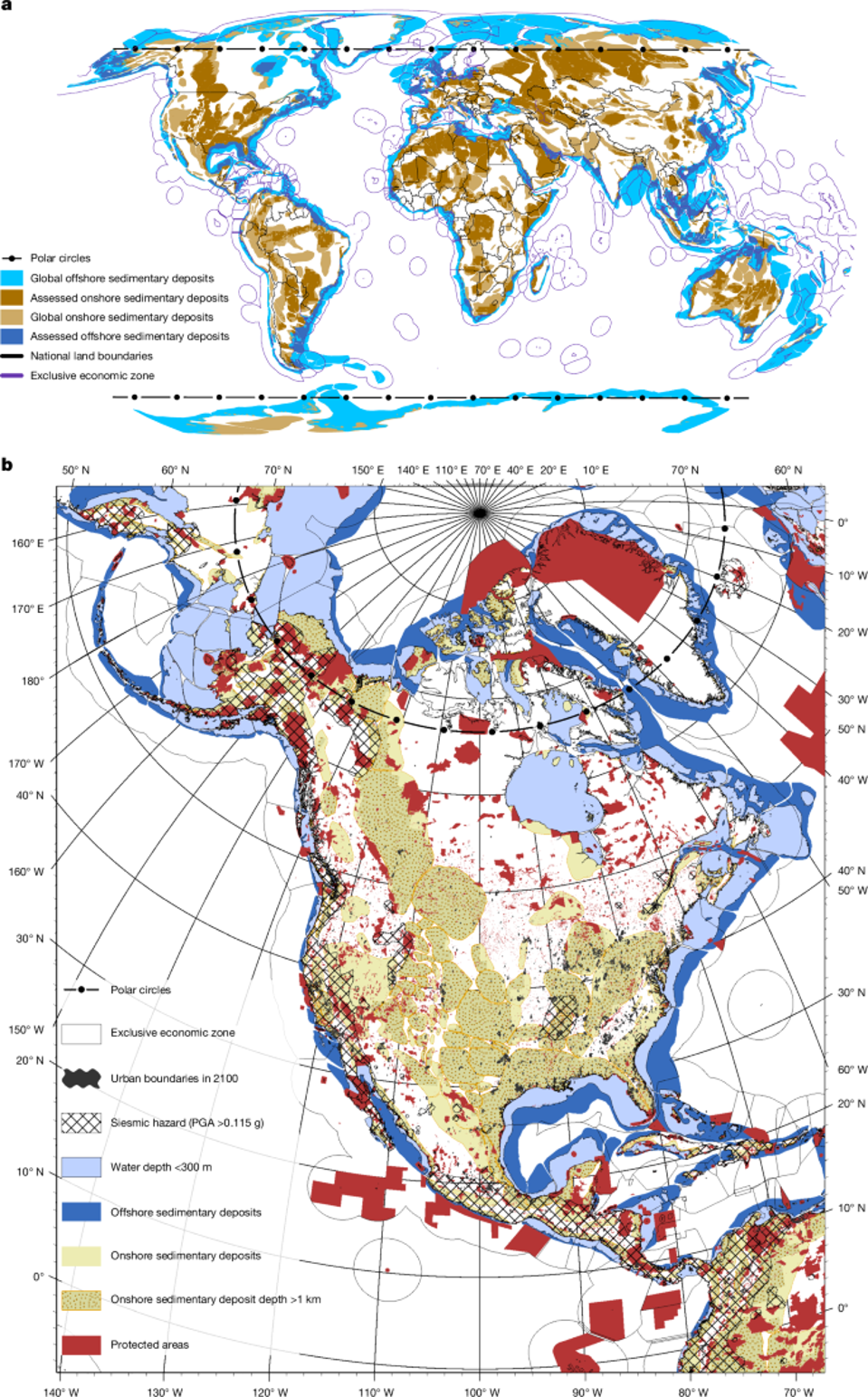We can’t solve problems if we don’t know what the problems are, and it’s better for false cures to be revealed early. From recent studies in Nature and similar journals: carbon capture has been over inflated; wind power is growing ever more obsolete; logging has lasting impacts on the wider ecosystem via soil disruptions.

a, Onshore (brown) and offshore (blue) sedimentary basins, including national terrestrial and maritime borders (that is, EEZs). Basin colors vary according to technical carbon-storage potential (lighter) and the assessed prudent carbon-storage potential (darker). b, The North American continent, including all exclusion layers. The prudent limit is estimated by accounting for the full storage technical potential, removing all precautionary exclusion layers and summing up available carbon storage from the basins that remain (yellow dotted and light blue areas). PGA, peak ground acceleration.
Nature and Esri, GEBCO, NOAA, National Geographic, DeLorme, HERE, Geonames.org and other contributors
Carbon Sequestration
Carbon Capture and Sequestration has been dealt a blow by a study published this week in Nature, the sequestration bit particularly. One idea optimists had for dealing with all of the carbon dioxide we’re releasing is to filter it out of power plants’ smokestacks, trap it, and then pump it deep underground. This study shows that due to cracks, porosity, population centers and other natural, geological considerations: “Fully using geologic storage for carbon removal caps the possible global temperature reduction to 0.7 °C” There’s now a firm upward limit on how much CO2 can be caught and kept away, meaning that even if other energy and cost concerns can be broken through, we won’t be able to store endless amounts of carbon safely underground, as previously thought. Some climate commentators were hoping this approach could drop the global temperature average significantly, comfortably several degrees Celsius: the new ceiling for this approach is a 0.7-degree reduction. We can’t rely on technology to solve our problems: we need to stop releasing CO2 into the atmosphere. We won’t be able to undue all of this damage.
Global Stilling
Wind is slowing. Heat waves are bad for wind power in 75% of cases, but in a bigger and permanent way, we know that by the end of the century wind speeds will have slowed such that 20% of turbines will be in locations with record breaking wind drought.
We must ensure that we use our finite resources effectively. A warming planet is lowering wind speeds which makes wind power less reliable.
Windtech International
These massive turbines require huge material inputs, and if they were to provide generations worth of power generation, then this would be a fine investment. It now appears that the opportunity cost is too high, and that we should use these valuable resources, including scare critical minerals, for solar and other methods that will continue to be effective at scale. Winds may be slowing, but no recent studies (that I’ve read) have stated that the sun will stop shining.
Logging Is Bad for the Environment
We always knew that densely canopied, old growth forests are superior for the wider ecosystem than agriculture and tree plantations. Tree farms have been promoted as a climate solution, the idea being that we can keep carbon sequestered as logs instead of letting it float of into the ever-warming atmosphere. On the face of it, perhaps one could make such an argument. When we consider the impacts from the soil carbon that’s released, it’s now clear that these logging sites turn from carbon sinks to carbon sources. An excerpt from the study that sums up their point, and should get the attention of anyone who works in carbon counting (bolding is mine):
“Alongside carbon being more likely to be released into the atmosphere, we estimate that selective logging increased the total flux of dissolved organic carbon in streams by 6.4% of the carbon extracted as timber. Although these estimates are short-lived, they should affect the millions of hectares that are logged annually. Carbon accounting of forestry, including as a natural climate solution, must now consider the transport and fate of DOM from land into water.”
Les Petits Ecrits islands, across from the Death Valley Section of the Conservation Reserve. Photograph by Allan Harris.
Allan Harris, Ontario.ca
We now understand that soil stable carbon will be released into nearby waterways, and that this Dissolved Organic Matter (DOM) is nontrivial. It pollutes rivers, and while the amount of carbon may taint the water for only two months or so, the soil can be altered for up to two years. In addition to all of the other reasons we have to dislike logging, we now have this one. Logging destroys old growth, densely canopied, rain regulating trees. While planting trees is an important strategy to combat climate change, we can’t rely on it to undo the damage of logging.
What’s better than removing carbon from the atmosphere? Not dumping out so much of it to begin with. What’s better than struggling to efficiently remove and replant trees? Leave them where they are. Human innovation can solve many of our modern problems. New technologies will help with some of our difficulties, but when considering the challenges we currently face, we shouldn’t overlook the basics. Prevention is the best medicine.








